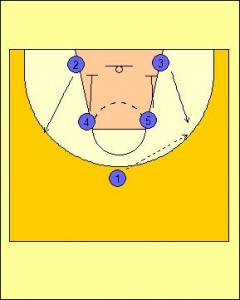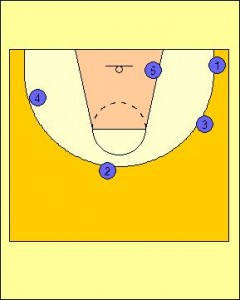Introduction to the Triangle Offense
The Triangle Offense has become one of the most famous offensive schemes in the game. It rose to prominence with the professional success of Phil Jackson, who utilised the offense both with the Chicago Bulls and the Los Angeles Lakers. Both times, the triangle offenses lead to multiple championships. The offense was actually developed by Sam Barry, who coached at USC in the 1940s and 1950s. However, it was in its early stages of inception, and wasn’t refined and fully advanced until Tex Winters, who played for Barry at USC, became a professional coach. As an assistant to Phil Jackson, he helped make the offense a staple of Coach Jackson’s high octane offense schemes.
The offense is popular because it is very adaptable to a wide range of player abilities and team strengths. The triangle offense is a very complicated offense system to run, and most teams even at a senior level will find its implementation challenging and time consuming. The offense requires that at least one of the interior players is proficient in scoring (either back to basketball or facing the basket). These players can be guards or big men, but without a post threat a defence can easily beat the triangle by cheating off of the primary post player and taking away the offense’s counters. For this reason, the triangle has been less popular in recent years, as many basketball leagues around the world, have moved away from post player offense and oriented themselves with heavy guard play.
The offense is difficult to implement, but if a team has two strong post threats, who understand the offense it can be difficult to defeat. The offense orients two scorers in post position, typically with one on the block and one in the high post near the free throw line. Another player in the strong side long corner often completes the Tactical triangle orientation. Out of this position, a number of options are available. If the post players are strong passers, high-low schemes make themselves attractive. If not, either player can be passed the ball for an isolation play, with cutters running off them as secondary options. A Further option while in the triangle formation is for the player in the strong side wing with the ball to run a pick and roll with the post player in the high post. By putting versatile players in a relatively small segment of the court, this offense presents mismatches and can create a bevy of high percentage shots for strong post players.
A key weakness for the offense is it is notoriously difficult to implement. If the offense is implemented incorrectly, it can be a mess, as spacing in the triangle is at a premium. Without players being properly spaced, no matter how good they are, the offense is tough to run. This will result in players moving into each other’s lanes to basket and clogging driving lanes with defenders.
For post players this crowding of the scoring areas will mean more pressure on passes into the post and quick rotations from the help defence. Alternatively, for perimeter players this crowding will make scoring difficult as players will find the defence can easily crowd driving lanes and increase the shooting distance from the basket.
In order to beat the triangle offense, you need to focus on limiting the offense’s output of the interior players. With quick doubles, hard traps, and overplaying the ball, you can force the post player to give up the ball. This type of defensive strategy will limit the offense to lower percentage perimeter shots.
If the team you are playing against does happen to have two strong post players, you should try to force the offense into bad spacing. Bad spacing is the biggest detriment to the triangle, and at most levels of basketball all that is needed to create bad spacing is heavy ball pressure and high levels of defensive effort.
The breakdown for the Triangle Offense diagrammed is a very simple play. The complete system adds various reads and actions to this structure to provide depth to the offensive strategy.

The triangle can start in a box formation, with the post players at the block (Four and Five).
Four (4) and Five (5) down screen for the perimeter players (Two and Three), who cut out to the wings.
The point guard (One) can pass to either wing (Two or Three) to setup the triangle. In this case, the pass is to the small forward (Three).

With the ball in the small forward’s hands, the shooting guard (Two) rotates to the top of the key.
The power forward (Four) rotates to the wing and takes the shooting guard’s (2) place.
The point guard (One) cuts through to the strong side long corner.

The offensive team is now in a triangle formation on the right side of the court.
Four (4) and Two (2) need to focus on maintaining spacing, but need to move their position to maintain a line of sight with the ball.
The players on the weak side of the floor (Four and Two) need to be looking for basket cut options if their defender becomes lazy or too active in help defence.
There are a number of options for the offensive team:
- Pass the ball into the center (Five) for post isolation.
- Have the center (5) set a ball screen with Three (3) for a pick and roll.
- Pass to the point guard (One) and set a double screen for a jumper.
Alternatively, the center (Five) can lift into the high post and then have both the point guard and small forward cut to the weak side of the floor after passing to the Five (5).






